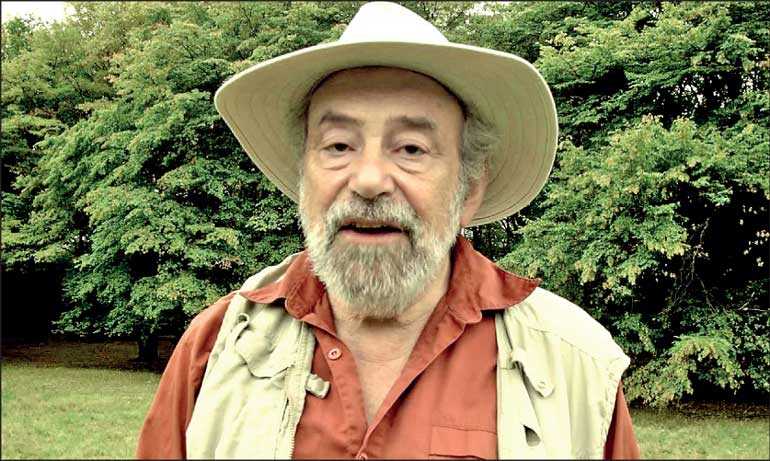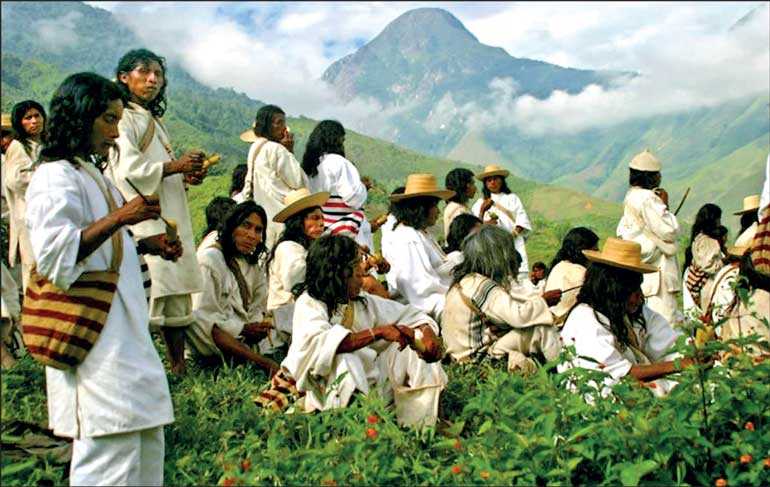Thursday Jan 08, 2026
Thursday Jan 08, 2026
Saturday, 30 May 2020 00:00 - - {{hitsCtrl.values.hits}}

BBC film maker Alan Ereira
By Suryamithra Vishwa
Last week in this page we featured an article about the indigenous people of the Sierra Nevada de Santa Marta mountains in northern Colombia who take seriously the duty they have inherited from thousands of generations to protect the mother we have all forgotten about; this earth. We featured their two warnings to the world, made in 1989 and 2012, and conveyed in two documentaries made by BBC film maker Alan Ereira.
The warnings sounded by the Kogi tribe (meaning the sun in Kogi language) was for modern man, described by them as ‘Younger Brother’ not to destroy mother earth. We mentioned last week that we would be featuring more about the Kogi, based on their belief in ‘Aluna’ or the consciousness or the mind of the ‘Great Mother,’ who they consider the force behind all of creation and sustenance.
To be unkind to the earth and exploit it for greed was unthinkable for mankind’s ancestors who feared retribution or punishment from the earth itself which housed man in the cycle of life, from birth to death. Asking permission from the tree to cut its branches or leaves for medicinal or housing needs and doing so using particular rituals so as to minimise the pain to it was a practice that was highly respected in Sri Lanka until quite recently, and is still practiced in some villages by humans who remember their duty to Mother Nature
These beliefs are beautifully described by the Kogi spiritual leaders, the Mamos in the documentary ‘Aluna,’ made by Ereira as a follow up to the first BBC documentary by him titled ‘From the Heart of The World: Elder Brother’s Warning’.
The Kogi of Columbia could be described as one of the few indigenous groups to staunchly succeed in protecting their traditional spiritual beliefs from Christianisation which had swept over many other indigenous groups the world over, following the invasion of Europeans into once Aborigine occupied areas, that are today known as the Western world; such as America, Australia, New Zealand and Canada.
The Kogi refuse to encase their feet in shoes because it will break their connection with the earth, which they consider to be part of their being and their Great Mother who they are entrusted to protect. Their communication with the Great Mother or Mother Earth is considered a core part of their spirituality and this is primarily carried out through water, connecting their consciousness to the water spirit.
Their spiritual values should resonate with the rest of us, wherever we are in the world, because, before present day religions came to being, we were all raised in the cradle of nature worship. We humans once reached an oneness with all of life, through a nature guided cosmic interaction. Aspects of this worldview is today looked at in sciences such as cosmology.
To be unkind to the earth and exploit it for greed was unthinkable for mankind’s ancestors who feared retribution or punishment from the earth itself which housed man in the cycle of life, from birth to death.

The Kogi are indigenous people of the Sierra Nevada de Santa Marta mountains in northern Colombia
Asking permission from the tree to cut its branches or leaves for medicinal or housing needs and doing so using particular rituals so as to minimise the pain to it was a practice that was highly respected in Sri Lanka until quite recently, and is still practiced in some villages by humans who remember their duty to Mother Nature.
While most other indigenous groups such as the Native Americans lost their battle, over the years after Europeans settled on their land, for the right to practice their nature based worship rituals, the Kogis fled to the high mountains to escape a similar fate by the Spanish conquers who arrived in the land in 1499 that is today known as Colombia
The life purpose of the Kogi is to care for the world and protect its balance. They say they are doing this because both the children and the Great Mother Earth would be kept surviving within a natural equilibrium it was meant to be thriving in. An equilibrium that is made unnatural, with increased deforestation, mining and turning what was once green into brick walls. This had turned the task of the Kogi into an almost impossible one. For the Kogis, their worry is being answerable to the Great Mother, the earth and it is this that made them shake off their isolation, to give Alan Ereira the opportunity to take to the world their message.
The word Mamo, as the Kogi spiritual leaders are called, means ‘enlightened’ (representation of light or the sun) and are different to shamans or curers. The Mamo are bearers of a complex Kogi cosmology which is based on dualities within nature and hemispheres.
The Mamos asked Ereira to convey the message to the world that it is sick and dying and that unless modern man, ‘Younger Brother’ changes his ways, that new kinds of sicknesses would engulf man and disasters such as landslides, floods and drought would worsen. This message was considered as coming from the ‘Heart of the World’ as this is what the location that is their home in the pyramid-shaped mountains of Sierra Nevada, are referred to. “We all are here to give a warning, animals die. The trees dry up… become ill. New illnesses would appear. There will be no cure or medicine for them,” the Mamos told Alan Ereira as featured in the 2012 documentary, titled ‘Aluna’. They also linked modern man’s increasing violence to other humans, to what he is doing to nature. “They say we mutilate the world because we do not remember the great mother,” says Ereira in the feature film released as a sequel to the first one made in 1989. “Unless we do something, the world is coming to an end,” he continues in the documentary, having first come to meet the Mamos in 1988
The Mamos asked Ereira to convey the message to the world that it is sick and dying and that unless modern man, ‘Younger Brother,’ changes his ways, that new kinds of sicknesses would engulf man and disasters such as landslides, floods and drought would worsen. This message was considered as coming from the ‘Heart of the World’ as this is what the location that is their home in the pyramid-shaped mountains of Sierra Nevada, are referred to.
“We all are here to give a warning, animals die. The trees dry up… become ill. New illnesses would appear. There will be no cure or medicine for them,” the Mamos told Alan Ereira as featured in the 2012 documentary, titled ‘Aluna’. They also linked modern man’s increasing violence to other humans, to what he is doing to nature.
“They say we mutilate the world because we do not remember the great mother,” says Ereira in the feature film released as a sequel to the first one made in 1989. “Unless we do something, the world is coming to an end,” he continues in the documentary, having first come to meet the Mamos in 1988.
“The earth is destroyed so much. But he (modern man) sees? No. Understand? No,” says a senior Mamos to the camera.
“The earth is a living body. It has veins and blood. Damaging certain places, is like cutting off a limb. It damages the whole body,” says the Kogi spiritual leader in ‘Aluna’.
Soon after, pointing to a particular location amongst the mountains the Kogi says: “This place is called Seshua. It is an Esuama. Esuamas connect the mountains with the shore. Younger Brother must listen. And stop causing damage. Or nature herself will finish us off.”
As another documentary ‘The Way of the Kogi,’ filmed and directed by Sophie Cooper and produced by the Institute for Man and Nature, shows more details of the Kogi and their attitude to the Sierra Nevada de Santa Marta mountains they live in, which for them is a sacred place where consciousness and wisdom abide. They consider this a core cradle to all that is related to nature in its pristine form; animals, plants, crops and seeds and there are trees that they consider especially essential for the survival of the tribe. Some of these trees have been cut even at the remote locations that they exist in by marauding man of the cities.
What the Kogi feels about their space within nature could be said of all of us and all of this planet earth, which is in total, sacred. It could be said that each of us are the children of the great mother and the protectors of her life and that everything of this earth is the repository of that which is pure and beautiful.
All of us also, once, long time ago, spoke deeply to nature as the Kogis still do. But our genetic memory may bear only the faintest recollection of this communication because we have now got used to a different world, where bricks have replaced trees and where our education does not involve nature.
What the Kogi feels about their space within nature could be said of all of us and all of this planet earth, which is in total, sacred. It could be said that each of us are the children of the great mother and the protectors of her life and that everything of this earth is the repository of that which is pure and beautiful. All of us also, once, long time ago, spoke deeply to nature as the Kogis still do. But our genetic memory may bear only the faintest recollection of this communication because we have now got used to a different world, where bricks have replaced trees and where our education does not involve nature. Yet, sometimes, even the most sceptical of us about the wisdom of the ancients, at times, when he or she is confronted with the natural world, in a quiet moment, may find a message being floated in the wind, that all is not right in this world which is preoccupied with creature comfort, speed, technology, wars and money making. We may then find, gazing at a tree in one of these epiphanies, that brick buildings do not produce oxygen and that without oxygen both the earth and us, will become thwarted, ill and perish. We may then realise that each of us have in fact a similar duty as the Kogi, to protect the harmony and balance of this earth and in doing so protect the survival of the human species
Yet, sometimes, even the most sceptical of us about the wisdom of the ancients, at times, when he or she is confronted with the natural world, in a quiet moment, may find a message being floated in the wind, that all is not right in this world which is preoccupied with creature comfort, speed, technology, wars and money making. We may then find, gazing at a tree in one of these epiphanies, that brick buildings do not produce oxygen and that without oxygen both the earth and us, will become thwarted, ill and perish.
We may then realise that each of us have in fact a similar duty as the Kogi, to protect the harmony and balance of this earth and in doing so protect the survival of the human species.
References:
https://ecohustler.com/culture/from-the-heart-of-the-world-the-elder-brothers-warning/
The BBC documentary of 1990, ‘From the Heart of the World: The Elder Brothers’ Warning – Kogi Message to Humanity’
The 2012 documentary ‘Aluna’ made by Alan Ereira
The documentary ‘The Way of the Kogi’ by Sophie Cooper